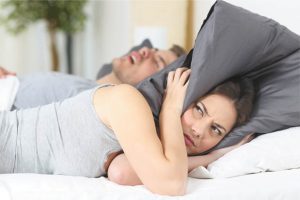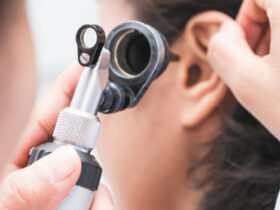By Dr. Mat Mouritsen
 Sleep apnea is a sleep disorder that can be quite dangerous. Those suffering from this disorder repeatedly stop and start breathing while they sleep. These disruptions diminish the quality of sleep and can lead to other health issues. Many times, sleep apnea goes undiagnosed since most of us are unaware of what is going on while we sleep. However, if you find yourself waking up tired and with a headache, it may be time to see a doctor and undergo some tests.
Sleep apnea is a sleep disorder that can be quite dangerous. Those suffering from this disorder repeatedly stop and start breathing while they sleep. These disruptions diminish the quality of sleep and can lead to other health issues. Many times, sleep apnea goes undiagnosed since most of us are unaware of what is going on while we sleep. However, if you find yourself waking up tired and with a headache, it may be time to see a doctor and undergo some tests.
Types of sleep apnea
There are three main types of sleep apnea.
Obstructive sleep apnea is the most common. It occurs when the throat muscles relax. Its symptoms include:
• Daytime sleepiness which can lead to a lack of ability to focus and irritability
• Morning headaches that last for hours after waking up
• Loud snoring
• Dry mouth when waking up
• Frequent nighttime bathroom trips
• Restlessness and/or sleepless for periods during the night
These symptoms can also be indicators of other health problems. Sleep apnea should only be diagnosed by a doctor using specific tests for an accurate diagnosis.
Central sleep apnea results from your brain not sending correct signals to the muscles that control breathing.
The symptoms of central sleep apnea are similar but with a few differences. They include:
• Nighttime wakefulness
• Morning headaches
• Daytime sleepiness that can lead to a lack of ability to focus
• Morning headaches
• Breathing that is irregular; slows down/speeds up/pauses throughout the night
With both types of sleep apnea, the patient rarely notices the nighttime breathing patterns or snoring and is generally made aware of the problem by a sleeping partner or caregiver.
Complex sleep apnea (also called treatment-emergent central sleep apnea) is a mix of both obstructive and central sleep apneas.
Causes of sleep apnea
Though the symptoms are similar, the causes of obstructive and central sleep apnea are different.
With obstructive sleep apnea, the muscles in the throat relax during sleep thereby reducing the airway and restricting the flow of air. These narrow airways produce snoring and the sleeper fails to get enough oxygen, thus causing the person to wake completely or partially to restore airflow. This happens repeatedly throughout the night and results in daytime sleepiness which then causes a lack of ability to focus, and so on.
Central sleep apnea is caused by a failure in the communication between the brain and the muscles that are responsible for breathing. The brain stem does not recognize carbon dioxide levels in the body while it sleeps. The result is slow and shallow breathing.
Treatment of sleep apnea
Treatments vary depending on the type of sleep apnea a patient is diagnosed with, but the goal is the same: to reduce breathing disruptions during the night and improve the quality of the patient’s sleep. The most common treatment for obstructive sleep apnea is to be connected to a positive airway pressure (PAP) machine throughout the night. The PAP keeps the airway open by pumping pressurized air through a hose and a mask worn on the face. A sleep study is essential in order to determine the correct calibration of the air pressure being pumped out. A continuous positive airway pressure (CPAP) device is always set to the same pressure level. However, a bi-level positive airway pressure (BiPAP) and auto-titrating positive airway pressure (APAP) send varying levels of air pressure throughout the night.
There are also mouthpieces made to treat OSA. There oral appliances hold the jaw or tongue in specific positions to aid in breathing throughout the night. They do not improve breathing like a PAP device, but can aid in reducing snoring and are less cumbersome than a PAP device.
In some cases, surgical removal of tissue in the throat may be a treatment option. There is also a surgical procedure to implant a device that stimulates the nerve that controls breathing.
Finally, there are several lifestyle changes that can help with sleep apnea. They may include:
• Losing weight
• Exercising regularly
• Avoiding alcohol
• Changing your sleeping position (no back sleeping)
Central sleep apnea treatment is usually focused on dealing with the medical problems causing the abnormal breathing. If symptoms are severe and not alleviated by treatment of the underlying cause, use of PAP devices may be helpful. Sometimes supplemental oxygen or medication is helpful as well.
If you believe that you are suffering from sleep apnea, contact Dr. Mat Mouritsen at Park Family Dental and Cosmetic Surgery. Dr. Mouritsen has studied with some of
the most prominent experts in the field of airway and sleep breathing disorders. As a member of airway prosthodontics, he continues to study and learn together with doctors around the world finding new ways to better understand and treat breathing related health issues. He is particularly passionate about this because he has several close family members that have been affected by sleep breathing disorders including sleep apnea. He has unbounded enthusiasm for helping people to find individual solutions that can result in dramatic changes in nighttime rest and overall health.
Park Family & Cosmetic Dentistry
690 Goodlette-Frank Rd. N.
239-330-4208










